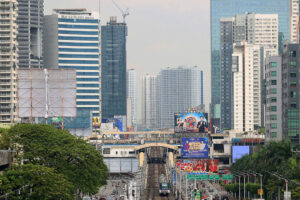By Kenneth Christiane L. Basilio, Reporter
PHILIPPINE lawmakers should craft policies that will stimulate private sector activity and bolster economic growth, a congressional think-tank said as it estimated full-year expansion to range between 5.52% and 5.74%.
Policymakers must improve the regulatory environment and foster a more competitive market to strengthen investor confidence and support economic activity, the Congressional Policy and Budget Research Department (CPBRD) said in a July paper. It did not give specific legislative recommendations.
“If the private sector is supported through measures that guarantee the stability of the economy, reduce the costs of doing business and allow firms to keep and reinvest more of their earnings, then there would be more actual productivity and more economic growth,” it said in the 32-page report, authored by David Joseph Emmanuel Barua Yap, Jr., Rutcher M. Lacaza and Edrei Y. Udaundo.
“It is incumbent for policymakers to recognize that it is the private sector that ultimately drives growth,” it added.
The Philippine economy grew by 5.4% in the first quarter, slowing from 5.9% a year ago, and performing below expectations due to sluggish private sector activity and persistent structural challenges, like weak productivity, weighed on growth, according to the CPBRD.
“While recent economic performance has remained positive, growth has consistently fallen short of government targets, reflecting both structural limitations and cyclical headwinds,” it said.
“Despite this, the Philippines retains meaningful growth potential, particularly if fundamentals are strengthened and key vulnerabilities are addressed,” it added.
In a low-growth trajectory, the think-tank projects gross domestic product (GDP) to expand by 5.69% in the second quarter, 6.22% in the third quarter and 4.75% in the fourth quarter, bringing full-year growth to 5.52%.
“This reflects a scenario where inflation remains sticky and monetary easing is delayed,” the CPBRD said. “This dampens consumption and investment, leading to more uneven growth that is increasingly sensitive to both global and domestic cost pressures.”
On the other hand, the CPBRD’s high-growth scenario sees GDP expanding by 5.76% in the second quarter, 6.64% in the third quarter and 5.16% in the fourth quarter, resulting in a 5.74% growth for the year.
“The high-growth trajectory presents a more optimistic path, supported by easing inflation, improved fiscal execution, and a gradual return of investor confidence,” the think-tank said.
Both the growth estimate trajectories fall within, albeit at the lower end of the government’s revised target of 5.5-6.5% for 2025, which the Development Budget Coordination Council adjusted in June to reflect heightened global uncertainties. It also narrowed the GDP growth target range to 6-7% for 2026 to 2028, from 6-8% previously.
The think-tank anticipates an economic slowdown in the latter part of the year, as persistent inflation, tight fiscal space, and mounting trade disruptions from US trade policies are expected to weigh more heavily on economic activity.
US President Donald J. Trump last month said that Washington had reached an agreement with the Philippines to impose a 19% tariff on the country’s exports, a percentage point lower than the 20% that he dangled ahead of the Aug. 1 deadline. The Philippines was initially levied a 17% rate in April.
“The reinstatement of these tariffs could disrupt global supply chains, dampen international trade and potentially trigger retaliatory measures,” the CPBRD said. “This could also make the country’s exports more expensive and less competitive, reducing external demand and leading to a decline in production.”
Most Philippine exports are intermediate goods, making it more vulnerable to realignments in global and regional value chains, the think-tank said. Electronics led the country’s exported products in June, totaling $3.89 billion and making up 55.4% of the country’s overall export value, based on government data.
The think-tank also warned that inflation remains a “central concern” to economic growth, even as recent data pointed to a moderation in consumer prices.
Inflation rose to 1.4% in June, inching up from 1.3% in May, but slower than 3.7% in the same month a year ago, preliminary government data showed.
“The crux of the matter is that prices remain elevated,” the CPBRD said. “The rate at which prices increase may have slowed but the accumulated inflationary pressures remain a significant challenge for consumers.” Household consumption drives the Philippine economy, making up 70% of GDP, according to the think-tank.
INFLATION ESTIMATESIn a separate 28-page report, the CPBRD projected inflation to stay within a “relatively low range” for the rest of 2025, with an average estimate between 1.88% and 2.17%. The consumer price index (CPI) averaged 1.75% in the first quarter, the think-tank said.
Its low-end estimate projects inflation to average 2.11% in the second quarter, 1.83% in the third quarter and 1.84% in the fourth quarter.
For its high-band estimate, the think-tank said inflation could average 2.32% in the second quarter, 2.42% in the third quarter and 2.16% in the fourth quarter.
“The estimates can be defined as cautiously optimistic,” the CPBRD said in the report by Mr. Yap, Jhoanne E. Santos and Jubels C. Aquino.
Inflation in the first six months of the year remained within the Philippine central bank’s 2-4% target band.
But the think-tank warned that current low inflation levels are largely propped up by government subsidies rather than by supply meeting demand, raising concerns about future price surges.
“The observed slowdown in the inflation rate is attributable, in no small part, to the publicly funded reductions in rice prices,” the CPBRD said. “Prices, therefore, can be argued to be artificially suppressed to some extent.”
“Instead of lower prices because of actual expansions in the supply of goods, prices are lowered because of taxpayer-funded subsidies,” it added.
The CPBRD said the allocation of public funds toward subsidizing rice raises concerns on the fiscal sustainability of the program.
“A strong argument can… be made that taxpayers are paying more — through direct and indirect taxes — or will eventually pay more — through debt payments in the future — for lower prices today,” it said.
Meanwhile, the think-tank said domestic inflationary pressures that pose the greatest risk to stoking inflation include hikes in electricity prices, transportation fares, and food prices.
“Elevated electricity rates may contribute to inflationary pressure as they increase the cost of production and distribution across sectors, thereby affecting consumer prices for goods and services,” it said.
Transport fare hikes could also “significantly affect the cost of living of lower-income households,” it added, noting that transport and utility costs comprise a large share of their monthly expenses.
“Combined with external challenges including peso depreciation, global oil price volatility and geopolitical tensions, [these] continue to pose significant upside risks to inflation,” the CPBRD said.

